The American Mount Everest Expedition of 1963 was a significant event in mountaineering history. In May that year, Jim Whittaker became the first American to summit Everest with his sherpa, Nawang Gombu. However, this was only half of the expedition’s story. The remarkable summit ascent took place on the Mount Everest West Ridge.
three weeks later, Tom Hornbein and Willi Unsoeld, attempted the unconquered West Ridge of Everest. Their approach differed from previous Everest expeditions as they prioritized style and route difficulty rather than simply “conquering” virgin summits.
The First American to Summit Everest in 1963
On May 4, 1963, James Ramsey Ullman, the appointed chronicler of the American Mount Everest Expedition, dispatched news of a major development from the expedition. On May 1, James “Big Jim” Whittaker, a towering six-foot-five-inch store manager from Seattle, became the first American to reach the summit of Mount Everest. Nevertheless, three weeks after his momentous accomplishment, another team was preparing an even more extraordinary endeavor. To attemp the unconquered Mount Everest West Ridge.
Initially, the identities of Whittaker and his Sherpa climbing companion, Nawang Gombu, remained undisclosed. Norman Dyhrenfurth, sought to prevent their achievements from overshadowing the efforts of other teams still bidding for the summit. At least two additional teams were in the midst of their own summit bids. With one of them charting a formidable new path up the Everest West Ridge.
Preparation for the 1963 Mount Everest West Ridge
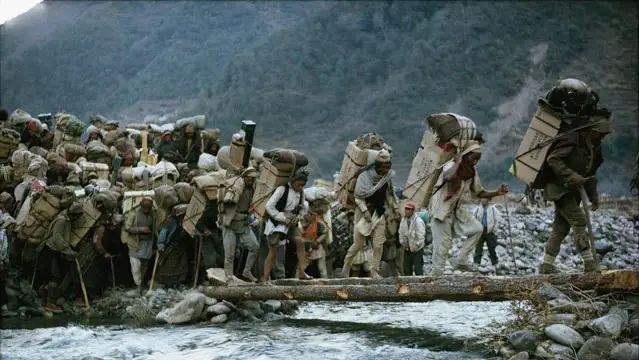
The expedition was a massive, military-style campaign with siege-like tactics, top-down chains of command, and a focus on the collective rather than the individual. Over 900 porters carried 27 tons of equipment into Base Camp! The expedition was organized with Norman Dyhrenfurth in charge and the other men were given ministerial titles. This approach was typical of expeditions to climb 8,000-meter peaks at the time.
Tom Hornbein and Unsoeld’s approach posed a significant risk to the expedition. As they wanted to tackle a more difficult route: Everest’s West Ridge. The summit push began with the team transporting supplies up the west shoulder to stock Camp III and establish Camp IV at 25,000 feet.
A windstorm on the west shoulder almost thwarted them on May 16. Almost losing their tents, the team held on for dear life as the strong winds reached 100+ mph. With the loss of equipment, the West Ridgers had given up on establishing and stocking the last two camps to reach the summit.
Despite this setback, Hornbein suggested a new plan to ascend to 27,000 feet and set up a single two-person tent at Camp V. Then Hornbein and Unsoeld would push for the summit in a single day and then descend toward the South Col. The plan was considered a “one last desperate effort” and a suicide mission. As they would not have enough supplies to return via the West Ridge of Everest if things didn’t go to plan. However, the climb marked a new age of light-and-fast climbing that would define the strict standards of modern Alpinism.
27,000 Feet High on the West Ridge of Everest:
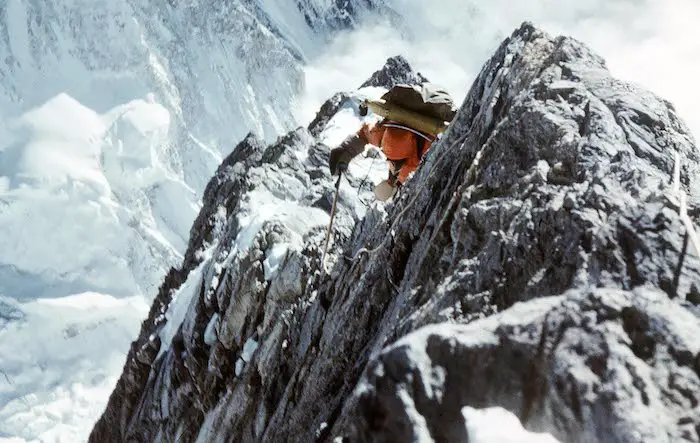
On May 21, five Sherpas led Hornbein and Unsoeld to an 18-inch-wide ledge right below the yellow band. At an altitude of 27,250 feet, the team helped Hornbein and Unsoeld set up their two-person tent and bid them farewell. Acknowledging that it could be the last time they saw each other. That night, Hornbein and Unsoeld ate a four-person ration of chicken-and-rice soup and grapefruit segments. Hornbein wrote a letter to his wife, knowing he would only see her again if he successfully summited the mountain.
They woke up at 4 AM, and put on their crampons before leaving camp just before seven. Th climb required them to traverse the couloir and climb two limestone pitches before reaching the mountain’s upper flanks. At noon they reached the upper flanks but they were disoriented and couldn’t figure out which route led to the summit. So they radioed to Whittaker in Base Camp for guidance, but he couldn’t help them.
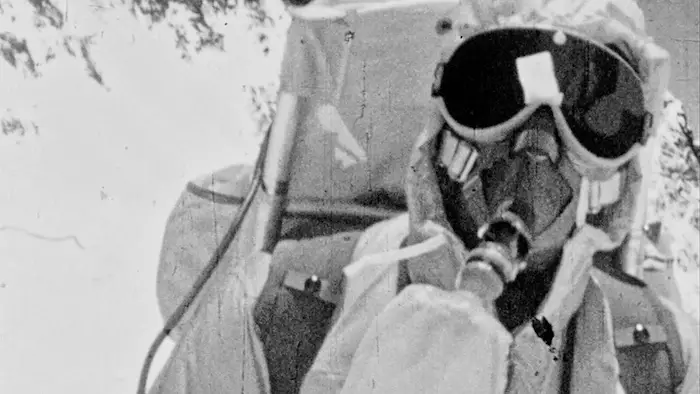
Unsoeld told Whittaker they had passed the point of no return, and Whittaker tried to persuade them to return. They decided to traverse back toward the West Ridge, which they thought would take them to the summit. After some time they stopped for lunch on a rocky slab in the middle of the traverse at 3 PM. After lunch theyencountered a series of rocky cliffs when they returned to the ridge Unsoeld led. They removed their crampons and slowly progressed toward the summit throughout the afternoon.
Unsoeld saw the American flag planted by Whittaker three weeks prior at around 6:15 PM. However with little daylight remaining and another 2,000 feet to descend, there was little time for celebration. Unsoeld contacted Maynard Miller on the radio, who answered from Camp II. They rappelled over the Hillary Step and soon found themselves enveloped in darkness. Hornbein and Unsoeld shouted into the night and eventually discovered Bishop and Jerstad. They bivouacked above 28,000 feet without a tent or sleeping bag at 12:30 AM.
Returning Back From The Summit
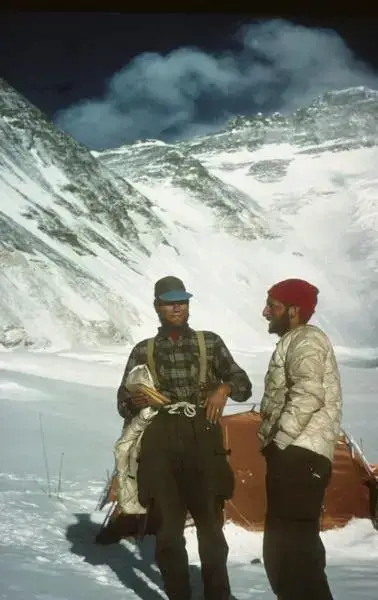
Following a stop for rest and a cup of tea at Camp VI, the team reached Camp II around 10:30 P.M., nearly 40 hours after beginning their ascent. During their descent along the Lhotse face, Unsoeld communicated via radio with his wife, who was at the American Embassy in Kathmandu. She made him promise this was his last major climb.
With the soles of their feet frostbitten, they limped back to the Khumbu icefall for one last time. Stopping briefly at the spot where Breitenbach had tragically lost his life a few days earlier.
Sherpas assisted Bishop and Unsoeld, down to Namche Bazaar from Base Camp. From there, they took a helicopter back to Kathmandu. In the aftermath, Unsoeld lost nine toes, and Bishop lost all ten.
The Difficulties of the Mount Everest West Ridge
The West Ridge remains one of the most challenging Everest climbing routes. Only 17 climbers have tried repeating variations of Hornbein and Unsoeld’s ascent in the past 50 years. Now called the Hornbein Couloir, is only part of the dangerous direct Everest West Ridge Route.
In 1974, a French expedition made the initial daring endeavor on Everest’s Direct West Ridge. However, the expedition ended tragically with an avalanche claiming the lives of six climbers. The route’s inaugural conquest occurred in 1979, accomplished by a Yugoslavian team. The achievement, however, remains the privilege of a select few. As it exclusively belongs to sizeable and exceptionally skilled Eastern European teams from an era when pioneering challenging new paths on Everest was in vogue.
The Everest West Ridge is distinguished by its most challenging segments concentrated at the summit. The daunting West Ridge Direct route has maintained its reputation as one of Everest’s lengthiest and most dangerous routes. Astonishingly, it has yet to witness a subsequent successful ascent in over three decades.
Other Notable Ascents of the Everest West Ridge Route:
Following the initial successful ascent, only nine other climbers have managed to reach the summit through the challenging Hornbein Couloir (West Ridge of Everest). The most recent of these summits occurred in 1991.
On May 10, 1980, Japanese climbers Tsuneoh Shigehiro and Takashi Ozaki achieved the first complete ascent of Everest’s north face via the Japanese and Hornbein Couloirs, starting from the Rongbuk Glacier in Tibet.
The next ascent of the West Ridge route on Everest was on May 20, 1986. During the expedition Canadian mountaineers Sharon Wood and Dwayne Congdon pioneered a novel route up the west shoulder, connecting it with the Hornbein Couloir to reach the summit. Additionally, the climb marked a historic moment as Sharon Wood became the first North American woman to conquer Everest.
On August 30, 1986, Swiss climbers Erhard Loretan and Jean Troillet accomplished the remarkable feat of scaling the north face of Everest in an uninterrupted alpine-style push, foregoing oxygen, ropes, and tents. Their astounding 37-hour ascent was followed by them sliding down the mountain in less than five hours.
The most recent climbs of Everest’s West Ridge was on May 24, 1989, when Polish mountaineer Andrzej Marciniak achieved a summit via the west ridge and the Hornbein Couloir. Finally, on May 20, 1991, Swedish climber Lars Cronlund reached the summit by navigating both the Japanese and Hornbein Couloirs.
The 1963 Mount Everest West Ridge Expedition:
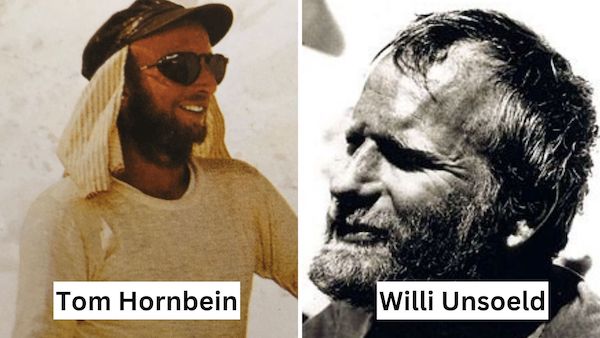
The 1963 Everest West Ridge expedition was one of the most important and amazing ascents of Everest at the time. Although it was overshadowed by America’s first ascent just a few days prior, the West Ridge team conquered Everest in fashion.
In a true Alpine style, the two man team summited the mountain with little more than a tent, while also descending from the opposite side of the mountain in a succeed or die situation. The American West Ridge Expedition in 1963 is still considered as one of the most inspiring and remarkable ascents of Everest to happen.
FAQs: 1963 Everest West Ridge Expedition
Below are some of the most frequently asked questions regarding Everest’s West Ridge and the 1963 Everest Expedition by the Americans.
The West Ridge Expedition recounts a triumphant American expedition that summited Mount Everest via two distinct routes. Tom Hornbein and Willi Unsoeld led a pioneering ascent of the Everest West Ridge. A route that had never been tried before and has only seen a handful of successful climbs since.
In 1974, a French team’s attempt at the West Ridge Direct on Everest resulted in tragedy as 6 members died in an avalanche. The first successful ascent was accomplished by a Yugoslavian team in 1979. However since then, there has only been one other successful ascent, and it has never been repeated since.
In 1979, the Yugoslav Mount Everest expedition (JAHE VII) accomplished the first-ever successful summit of Mount Everest (8,848m) via the entire West Ridge route on the North Face. This was the seventh Himalayan expedition by the Yugoslav alpinist team, and marked their inaugural ascent to the highest peak of Mount Everest.
The 1963 Everest expedition was made up of a 10 member team. Including Jake Breitenbach, Jim Whittaker, Willi Unsoeld, Lute Jerstad, Tom Hornbein, Dave Dingman, Barry Bishop, William Siri as the deputy team leader, Al Auten as the radio operator, and Gil Roberts as the team doctor.
